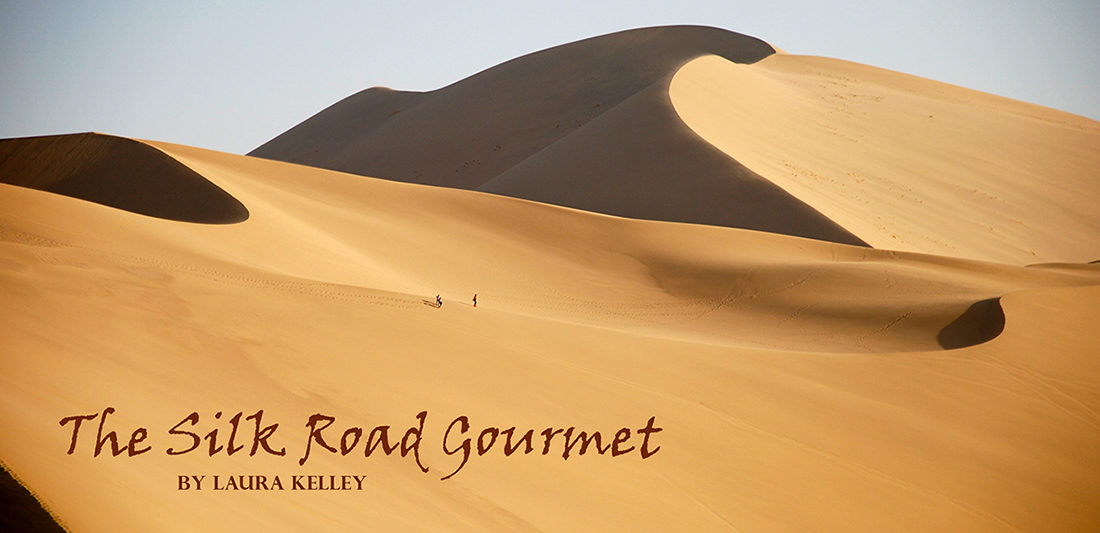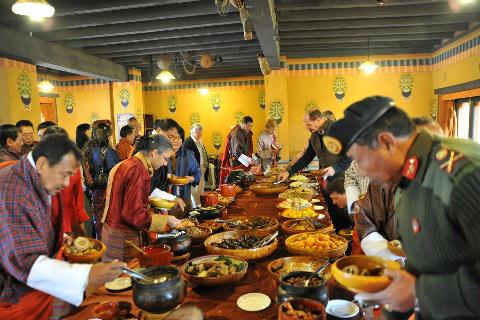A few years back, Ruth Reichl was quoted as saying that the Himalayan Kingdom of Bhutan had, “the world’s worst cuisine.” That quote angered me when I read it and has haunted me ever since. First of all, it isn’t true. Second of all, the statement is in itself nonsensical. How can someone proclaim something the “worst” without qualifying which characteristics earned it such a dubious honor? Is it the frequent use of yak dairy that offends? Is it the chili peppers? Ms. Reichl, please elaborate. Her comment reminded me of the scene in the movie Amadeus when Emperor Joseph II declared that there were simply, “too many notes” in Mozart’s opera Abduction from the Seraglio.
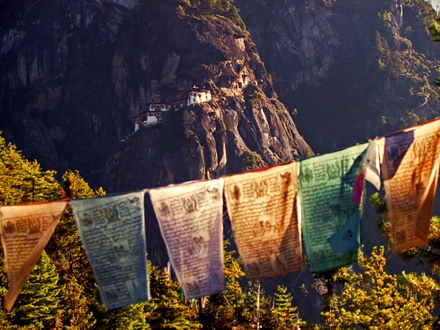
Restaurants in the U.S. and Europe purporting to serve Bhutanese food usually serve Nepali or Tibetan food with only one or two Bhutanese dishes peppering the menu. Sometimes, even these dishes are Bhutanese in name only and have little in common with the dish as one would experience from the hands of a skilled Bhutanese cook. I have seen one blog rave of Ema Datsi, Bhutan’s famous chili and cheese dish when in fact, he was served mixed vegetables and rice.
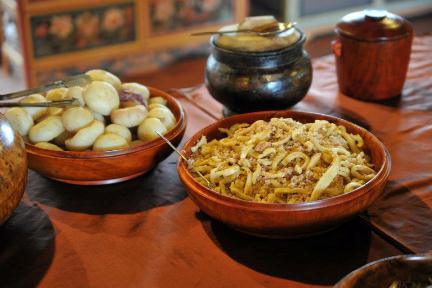
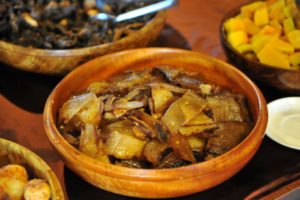
Although many people keep vegetarian, a selection of meat abounds from the commonly enjoyed pork and chicken to beef, water buffalo and yummy yak. Fish is also eaten, but is usually smoked or dried before cooking – at least traditionally. Delicious vegetables are everywhere if you look for them. From broccoli, cauliflower, corn, cucumbers and cabbage to potatoes, radishes (daikon), carrots, to eggplant, string beans, onions and garlic, and of course peppers both hot and sweet. Pulses include several types of peas and beans as well as lentils. Commonly enjoyed fruits are apples, delicious pears, and also mandarin oranges, but quinces, a large selection of berries, tomatoes, pumpkins, peaches and plums, and cherries, persimmons and jackfruit are also eaten. Almost all dairy, except that for complementary feeding of infants and a few beverages is eaten as butter or cheese. Yak is probably the most common dairy, but milk from cows, goats and buffaloes is also used for milder-tasting products. Grains eaten include rice, barley, wheat, millet, and maize, and flour is also made from buckwheat and pulses. Sweeteners are cane sugars, honey and sap from local trees.
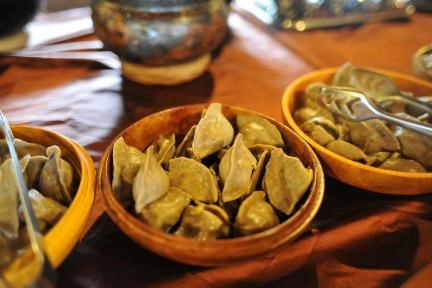
How cooks put these varied ingredients together is also extremely varied by geographic location, family tradition and personal preference and individual taste. There are stir fries, curries and stews; roasts, braises and baked dishes. There are salted, smoked, boiled and dried foods, and there are also dishes with flexible preparations and presentations, such as those that can either be a soup or noodles with sauce. There are unique fermented foods and pickles that are delicious, sweet and sour at the same time.
The lists above are by no means intended to be exhaustive lists of available foods in Bhutan, but only a sampler of some of the most commonly eaten foods, ingredients and flavorings. However, even with the meager offering of food to be found in these lists, it should be clear that there is no lack of basic foods in Bhutan to somehow limit the cuisine. In fact, the range of its geography from sub-tropical to alpine and from lowland to highland allows for an extraordinary variety of foods to be cultivated or gathered and eaten.
__________
Roots and Relationships
To begin to understand Bhutanese cuisine it is necessary to know the basic history of the people and the importance of Bhutan in regional and in Silk Road trade. Although archaeological evidence (stone tools, megaliths and building foundations) suggests that Bhutan was inhabited at least as far back as the second millennia BCE, most modern Bhutanese trace their ancestry back to the Tibetan migrations into Bhutan in the 7th Century ACE. The Tibetans brought with them their food culture, but that culture soon began to incorporate new ingredients that they found in Bhutan’s fertile valleys and hills. This adaptation continued until Bhutanese food developed its own unique character. Of course cuisines are always evolving and Bhutan’s cuisine is changing rapidly today.
Some dishes, however, still bear marked similarity between the two nations such as Shamdeh or Shamdrey a dish prepared with meat and potatoes and served over rice. Both dishes contain ginger, garlic, onion (of some sort), and tomato. The major differences are the choice of meats – the Bhutanese favor pork and beef and the Tibetans favor beef and lamb or mutton – and the spicing. The characteristic star anise flavor of the Tibetan dish is missing from the Bhutanese preparation that opts only for the use of cinnamon as the dominant flavor. The traditional presentation of the Bhutanese dish also includes slices of egg when available.
On the Silk Road, Bhutan served as an important link and trade partner between Assam and Bengal in the South and Tibet in the North. The Bhutanese traded ponies, sheep, and dogs, chilies, textiles and other spices and in return received rice, betel, dried fish, and all-important rock salt from its trade partners. Other items brought into India by Arab merchants and into Tibet by the Chinese and Central Asians were also traded. So, far from being isolated, the Bhutanese were part of the Old World’s global economy brought about by the Silk Road. Thus cinnamon from Sri Lanka and cloves from Indonesia were incorporated into the litany of Bhutanese foods.
__________
The Folk Heritage Museum Restaurant
Since 2001, the Bhutanese Folk Heritage Museum in Thimphu has been educating its citizens and visitors about traditional ways of life with displays of artifacts from the rural households. In addition to exhibits, there are also docent-led programs to teach skills – such as proper etiquette for eating with one’s fingers, extracting oil from seeds or brewing ara, the traditional moonshine – that are rapidly vanishing as international and modern lifestyles are adopted by its citizens.
Just a few months ago, in February, a restaurant opened at the Folk Heritage Museum that intends to educate visitors about Bhutan’s rich and delicious food culture and cuisine. It already has over 160 dishes (60 vegetarian and 100 non-vegetarian) on its menu and has hosted tastings of Bhutanese dishes. Menus are seasonal and ingredients are sourced from local farmers.
The restaurant/café arose out of the patronage of the Queen Mother Ashi Dorji Wangmo Wangchuck and is a welcome addition for those of us who would like to learn more about Bhutan’s traditional cuisine. Next week, from September 25 to the 27th, the restaurant is hosting two days of celebrations for the Tsechu Food Festival. Alas, I have no plans to be there, but I will raise a cup of mistletoe tea to those participating and wish that I was.
__________
The Silk Road Gourmet
I am always developing one recipe or another, and recently I’ve been working on a few from Bhutan that will be included in the second volume of The Silk Road Gourmet. A couple of evenings ago the whole family dined on a delicious meal of Bhutanese Roast Pork Ribs (Tsipsha Pan). In this dish (pictured below, in preparation) pork ribs are seasoned with salt, cinnamon, Szechuan pepper, and ground perilla and onion seeds. This is cooked briefly at high temperature on a bed of greens (I used mustard greens) and then the meat is covered with a sauté of caramelized onions, roasted tomatoes, hot chilies, ginger and garlic and spices, along with some more greens and slow roasted at low temperature until the meat drips off the bone. In true Bhutanese fashion, another variation of this dish can be cooked as a braise.
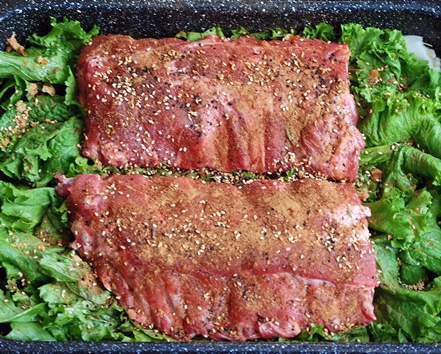
I used finger-hot chilies, which are not as spicy as those used in Bhutan (only about 30,000 Scovilles), but I used a lot of them – 12 for the vegetable sauté for the roast and 20 for the ema huem da datsi preparation served as a side dish. I also left the seeds and the placenta in place after slicing the chilies lengthwise to leave the full heat intact. I served both dishes with Bhutan’s fantastic red rice. As to cheese for the datsi, I used Turkish, whole milk feta mixed with gorgonzola to try to approximate the strong flavor and sour tang of Yak’s milk – it was wonderful (even if I do say so myself). I served the mustard greens that the meat was cooked in as an accompanying vegetable and they were delicious as well. Even our kids ate it, although my son, who has a heat-sensitive palate steered clear of the ema datsi.
You can look forward to these and other Bhutanese recipes, hopefully next year when the next volume comes out. Till then, keep traveling the world in your kitchens. (Words by Laura Kelley. Photo of the Tiger’s Nest Monastery, Paro by Wouter Tolenaar @ Dreamstime.com; photo of Bhutanese Roast Pork Ribs (Tsipsha Pan) by Laura Kelley, and other photos borrowed from the Folk Heritage Museum’s Facebook Page).
